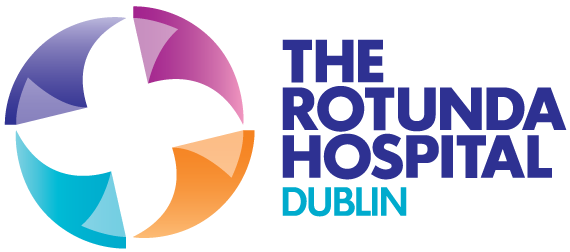Pregnancy is one of the most important journeys that you will ever go on. To help you understand as much as possible about your pregnancy, this section will take you through your pregnancy week by week, to the day of the birth of your baby and it will give you information on the things that you should do during the different stages of pregnancy.
How your baby develops and your body responds
The Rotunda Hospital Dublin
Calculate your expected date of delivery
Most people talk about pregnancy lasting for nine months, but we generally measure pregnancy by weeks, lasting 40 – 42 weeks from conception. Your doctor or midwife will calculate the date you can expect your baby to be born based on the first day of your last menstrual period. They base it on you having a regular cycle of 28 days.
To calculate your expected date of delivery (EDD) add seven days and nine months to the first day of your last menstrual period. For example, if the first day of your last period was on the 2nd of March, your expected date of delivery (EDD) is the 9th of December. Most women will go into spontaneous labour between 37 – 42 weeks of pregnancy. There is no way to accurately predict the exact delivery date.
Trimesters of pregnancy
Medically a pregnancy is divided into three trimesters. The first trimester (12 weeks) is the crucial period when all the organs, muscles and bones of your baby are formed. The second trimester is taken up with rapid growth of your baby. During this time you will start to feel your baby kicking; your baby will be able to swallow and make facial expressions and can hear sounds. In the third trimester, from 28 weeks the baby will undergo an important final phase of growth and maturation of all its organs in preparation for birth.
The first trimester
week 0-12
During the first trimester your baby will grow from a cluster of cells into a recognisable fetus (baby) that is 5 cm (2 inches) long. It is the time when the foundations of your pregnancy are being laid down. The tiny cells produce biochemical messengers that will send signals to your body to stop your periods. The different layers of the cells will develop to create specific parts of the baby’s body. By week five the building blocks for your baby’s organs are already in place. The heart begins to form and circulate blood. The position of the spine and digestive system are in place. Your baby is only 2 mm long at the end of week 5.
Your changing body
In the first few weeks of pregnancy you will not look or feel pregnant, yet your body is already having major changes because you start to produce a lot of pregnancy hormones immediately after conception. The hormone oestrogen thickens the lining of your womb (uterus) and other hormones help the baby to settle down in your womb. Some women are very sensitive to the changes in their body and they know they are pregnant even before they miss a period. Women often feel that their breasts are more tender; you may notice that you want to pass urine more often, and for some women they can feel tired and sick.
Things to do:
- If you are not already taking folic acid you should start now. You can get it in any pharmacy. Taking folic acid is very important as it reduces the risk of the baby developing a neural tube condition such as spina bifida. This happens when the tissues that fold to form the neural tube when the baby is growing in the womb do not close completely; the defect can happen anywhere from the base of the skull to the lower part of the back called the sacrum.
- Make an effort to change your lifestyle by stopping smoking and drinking alcohol and/or taking recreational drugs.
- Be good to yourself by eating little and often. Food hygiene is essential to protect you and your baby against the risk of food poisoning.
- Book an antenatal visit with your doctor (GP) and your maternity hospital.
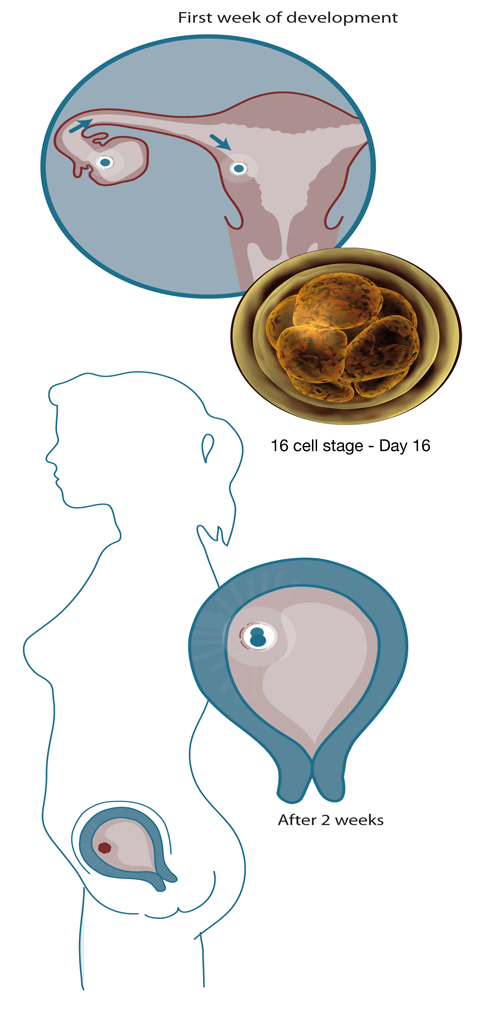
Weeks 6-10
During these four weeks, your developing baby will start to change a lot in appearance, so by week 10 your little baby is starting to look like a human being. At week 6 your baby is sprouting limb buds from which the arms and legs will develop. The head continues to grow quicker than any other part of the body in order to accommodate the developing brain. By the end of week 6 your baby is 5 mm (0.2 inch) long.
Week 7
Your baby is 12 mm (0.5 inch) long and the heartbeat can be seen on ultrasound scan. Your baby’s eyes and ears are developing quickly; by the end of week 8, the eyes already contain some colour. Your baby is now 15 mm (0.6 inch) long.
Week 9
The folds of skin making up the limb buds start to form cartilage, which will later grow into bones. You can see your baby’s movements on ultrasound but you will not feel any of this for some time. The baby is 22 mm (0.9 inch) long by the end of the week 10. You can recognise its eyes but they will stay hidden behind sealed lids and cannot work until later in the second trimester, when the nervous system forms. The heart has developed with four definitive chambers; the heart is beating 160 times per minute. Your baby is now 33 mm (1.3 inches) long.
Week 11
Your baby’s face is fully formed; the liver, stomach and spleen are all in place. You can see the baby’s ears, and the inner ear, which is responsible for balance and hearing, is formed. Your baby has 32 permanent teeth buds. The baby is now 40 mm (1.6 inches) long.
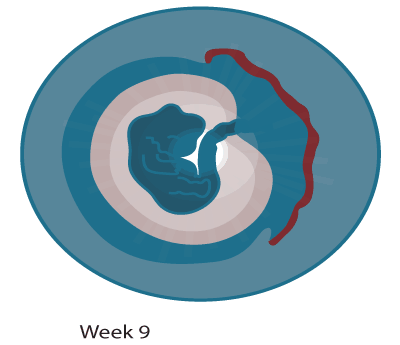
Week 12
Your baby now looks like a human being; its spine, fingers and toes are fully formed. Your baby is now 5 cm (2 inches) long and weighs 18 grams (0.6 ounce). It is during this initial period of development that things like drugs, viruses and environmental factors (anything that comes into direct contact with the mother or baby) can easily damage a baby; so pregnant women should avoid all of these.
Your changing body:
During the early stages of your pregnancy your uterus (womb) will grow a lot in size. By eight weeks it is the size of a medium sized orange, while at 10 weeks it is the size of a grapefruit. To make your womb grow, blood flow from your heart increases. Because of these changes in your circulatory system, you will become aware of differences in the way your body is working; for example changes in your breasts, wanting to pass urine more often and your skin will either become clearer or drier than usual.
Physically some women go through the first trimester feeling well, however, it is common to feel very tired, and nausea can be a major problem. Morning sickness is the most talked about side effect of pregnancy, as 70 – 80% of women will experience it. Morning sickness can happen at any time of the day. Occasionally, some women cannot keep any food or drinks in their stomach and they become dehydrated and weak, and need to go to hospital for treatment.
Emotionally, you may find your moods change a lot. One minute you could be talking excitedly about the pregnancy and the next you are crying over something very unimportant. This is because of the major hormonal changes that happen in early pregnancy and will settle later in your pregnancy.
The second trimester
In the second trimester, your baby will grow steadily and the baby’s organs will develop more. The overall size of the baby will increase by four times and its weight will increase by 30 times.
By week 13:
Your baby’s facial bones are complete and the delicate facial features are more easily recognised. The head is the largest part of the baby but very soon its body growth will catch up. Your baby at this time is very thin and is covered by a fine translucent skin. Although the eyelids are fully formed, they will stay closed for the most part of the second trimester. Your baby can be seen moving freely on ultrasound scan. The placenta (afterbirth) is formed, which provides oxygen and nutrition from your circulation to the baby. Your baby by the end of week 13 is 6 cm (2.4 inches) long and weighs about 30 grams (1 ounce).
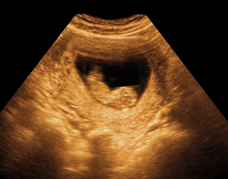
Week 14:
Your baby can make a fist and suck its thumb. Your baby’s arms are long enough for its hands to meet together over its body. The amniotic fluid or liquor (sac of water around the baby) is increasing which is important so that your baby is freer to move which helps the baby’s muscles to develop. Your baby’s kidneys start to work. By the end of this week your baby has grown to 7 cm (2.7 inches) and its weight has gone up to 45 grams (1.5 ounces). Over the next few weeks, your baby grows at a regular rate; its legs in particular have an amazing growth spurt and are now longer than the arms. From now on, your baby’s rate of growth of its body and limbs will slow down; however, your baby will continue to put on weight at a steady pace. This physical slow down helps your baby to develop in different ways. For example, its lungs, digestive and nervous systems are slowly maturing.
By the end of week 16:
Your baby will measure 9 cm (3.5 inches) and weigh 90 grams (3 ounces).
Week 18:
It is possible that you are now feeling your baby kick for the first time. In the beginning you may think it is ‘wind’ until you realise there is a pattern to these gentle movements. Your baby at this stage can know the difference between sweet and bitter flavours as its taste buds are developed. Your baby can open its mouth and stick out its tongue, which you can often see on ultrasound. A very fine hair called lanugo covers the baby’s entire body; it is thought that this helps to keep the baby warm until it has enough fat stores.
At 19 weeks:
Your baby’s teeth are formed in its gums. Your baby can hear sounds from outside your body and will respond if you play loud or easy music. All these developments in your baby’s senses are due to the fact that its nervous system is developing and maturing.
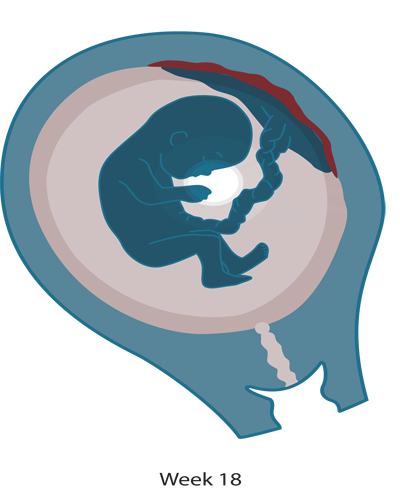
By the end of the 20th week:
Your baby measures 13 cms (5 inches) and weighs 240 grams (8 ounces). Most women are aware of their baby’s movements around this time.
By 24 weeks:
Your baby is 17 cm (6.5 inches) long and weighs about 500 grams (17.5 ounces). Your baby is able to open and close its mouth and can swallow a large amount of amniotic fluid.
By the 26 week:
The volume of amniotic fluid has increased to about 500 mls. Even though your baby’s lungs are not quite fully developed, the baby has now reached a level of development where it may survive outside the womb with the help of specialist care in the neonatal unit.
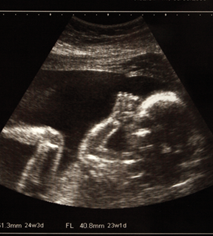
In the weeks leading up to week 28:
Important developments are happening inside your baby’s body. Because your baby’s nervous system and skeleton are developing more, the baby’s movements become more deliberate. Your baby can move freely, somersault and hiccough. It is even thought that the baby can tell the difference between you and your partner’s voice. You will also notice a pattern between your baby being asleep and awake; however, this often does not match your own every day and night pattern.
Your changing body:
Now that you are in the second trimester of your pregnancy, you will be much more confident that your baby is a reality. You will probably feel less sick and start to get more energy back into your life. You will also notice that your waist is beginning to get bigger and a bump is beginning to form in your tummy. You can get increased pigmentation of your skin at this time and as a result you will notice the area around your nipples (areola) will become darker. Also, a dark line may form down the centre of your tummy, which is called linea nigra, and moles and birthmarks will also get darker. All these changes are very normal and happen because you have more of the hormone oestrogen in your body.
There is a huge increase in how much blood goes around your body. For example, at the beginning of the second trimester 25% of your blood is directed to your womb in order to support your growing baby and placenta (afterbirth). Just 2% of your blood volume went to your womb before the pregnancy. Because of this some women will feel their heart beating faster and may complain of having palpitations.
As your womb continues to grow you may notice that you develop stretch marks on your tummy and/or around your breasts. This is caused by the collagen beneath the skin tearing as it stretches, as your body gets bigger. There are a number of lotions and creams that you can buy, which may help to reduce the effects of the stretch marks. You will also find that you will feel hungrier as you start to enjoy your meals again. It is important that you eat a balanced diet and remember that it is the quality of the food rather than how much you eat that counts.
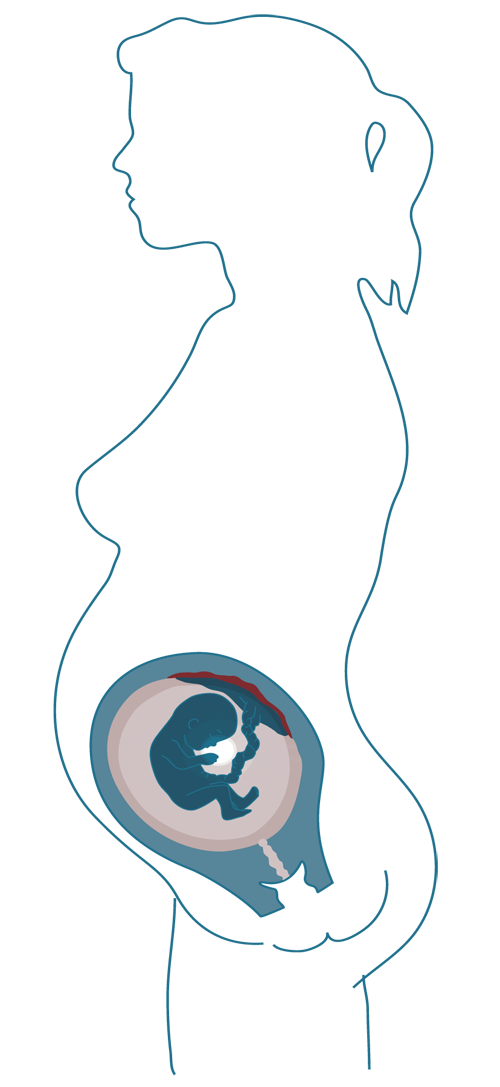
Things to do:
- Make a conscious effort to cut down or stop smoking, drinking alcohol and/or taking drugs.
- Have a balanced diet and keep fit.
- Sign up for parent education classes.
- Visit the dentist for a check-up.
- If you are pregnant during the flu season (October to March/April), you should get the seasonal flu vaccine from your GP.
- Pertussis (whooping cough) vaccination is recommended any time after 16 weeks of pregnancy.
- Tell your employer that you are pregnant and apply for maternity leave.
The third trimester
Weeks 28-42
Early in this trimester your baby is able to survive if delivered, although it would still need medical help and constant monitoring in the neonatal unit. The last weeks in the womb are very important as it helps the baby’s lungs, digestive system and brain to develop further in order that they can work well when your baby is born.
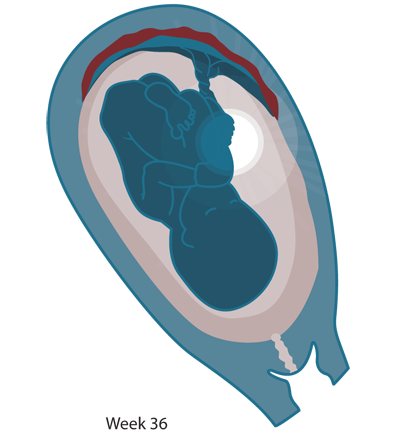
Week 29:
Your baby will weigh about 1 kg (2.2 lbs). From now until week 32 your baby can put on as much as 500 grams (17 ounces) in weight a week. Your baby’s lungs will be producing a substance called surfactant, which the baby needs to help it breathe after birth, by helping its lungs to be as elastic as possible to be able to expand fully. You will find that your baby’s movements are much stronger and you recognise a definite pattern of movements. Your baby’s eyes are opening and closing and he or she is learning to focus. Your baby’s fingernails reach to the tips of its fingers but its toenails will still need a few more weeks to reach the end of the toes.
Most babies will lie head down (cephalic) by week 34 especially if it is your first baby. However, some babies will take another week or two before they will settle down in position for birth. Indeed some babies will decide to come bottom first (breech). If by 37 – 38 weeks your baby is not in the cephalic (head down) position, the doctor and midwife will talk to you about birth options. By 36 weeks your baby will weigh 3 kg (6.5 lbs) and you are now in the final lap before birth.
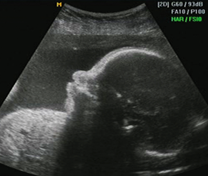
From week 36:
Your baby’s organs are being fine-tuned for birth; the lungs mature, and the digestive system can take liquid foods. The lanugo hair will start to disappear from your baby’s body and his or her immune system can give protection against a variety of infections. If your due date arrives and you have not gone into labour, don’t worry as this is very common, especially for first time mothers.
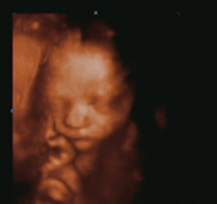
Your changing body:
Your womb is getting bigger at a steady rate and your stomach and intestines get squashed which means you can get heartburn. Your bladder is also not used to this pressure and can no longer hold as much urine, so you may want to go to the toilet more often. Sometimes you might get a small leak of urine when you sneeze, cough or laugh; this is called stress incontinence. Some women are not sure if the baby’s waters are broken. If you are not sure you should check with your midwife or doctor. Many women will complain that they feel breathless, because their womb is growing and it pushes the contents of their tummy up against their diaphragm so their lungs have less room to expand when they try to take a deep breath.
Your body needs to hold extra fluid and this generally settles on your legs and hands; because of this you will notice they may become swollen. However, if your face or legs suddenly become puffy or swollen it could be a sign of pre-eclampsia and you should go to your doctor or midwife as soon as possible.
With your growing womb you may have problems with sleeping and doing every day things such as shopping or cleaning. Lack of sleep can affect how you feel physically during the day. You should try to involve your partner as much as possible in work in the house, so that you can get some extra rest. Lying on your back can be difficult as it can lower your blood pressure and make you feel light-headed. It is best if you can lie on your side with the support of a pillow at your back.
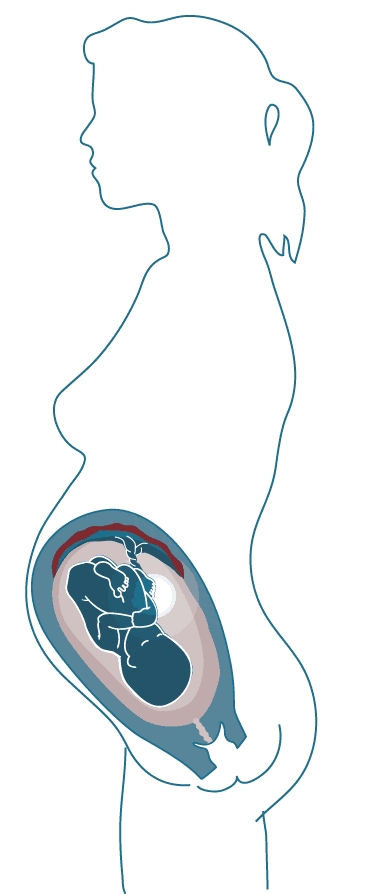
From now until the end of your pregnancy, your womb will start to practice contracting so it can prepare for labour. These tightenings are called Braxton Hicks contractions. In the beginning these can be very mild; however, near the end of the pregnancy they can become strong and uncomfortable. Emotionally, you may find it hard to concentrate on specific tasks; you can become weepy for no particular reason.
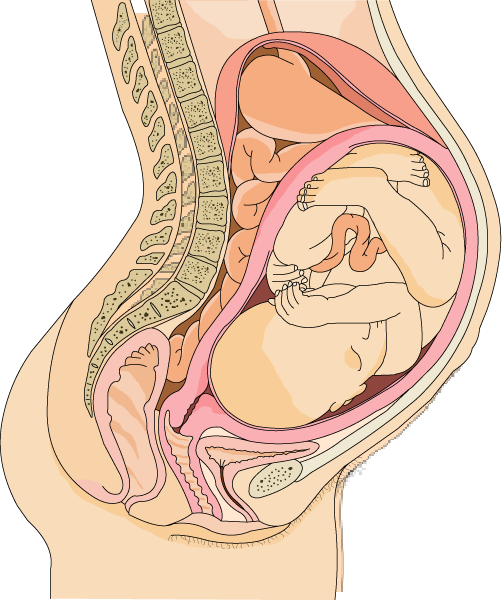
Things to do:
- Go to the doctor or midwife on a regular basis.
- Go to parent education classes with your partner.
- Keep active and eat well.
- Pack your bag for birth and plan a route to the hospital.
- Have a back-up child minder if you have other young children.
